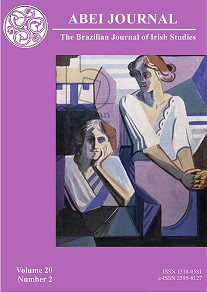Of Bees, Fairies, and Women: Lisa Carey's Feminist and Parodical Rewriting of Tradition in The Stolen Child (2017)
DOI:
https://doi.org/10.37389/abei.v20i2.3199Palavras-chave:
Irish folklore; contemporary literature; parody; feminism; motherhood; fairies; changeling; BrigidResumo
This article examines Lisa Carey’s recent novel, which offers a rewriting of both folkloric and Yeatsian traditions. The author reuses fairy beliefs, bee folklore, and religious traditions around Saint Brigid and Saint Gobnait, in contrast with the demands of modern life, to illustrate the antagonistic pulls on the protagonists. Through this rewriting of Irish folklore, she offers a feminist parody of tradition, in Linda Hutcheon’s sense of the word. The North American writer reuses Irish fairy beliefs to question the representation of motherhood through her character of Emer, and rewrites the legend of Saint Brigid, to turn her into a feminist model for the female protagonists.
Keywords: Irish folklore; contemporary literature; parody; feminism; motherhood; fairies; changeling; Brigid.


